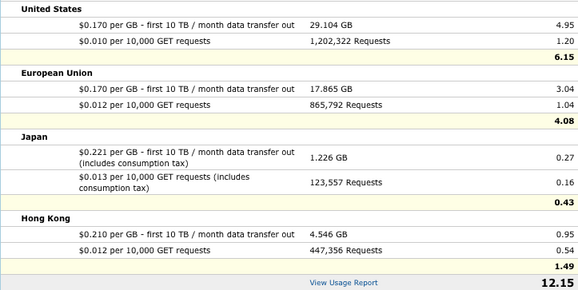Here at jQuery we’ve been using Amazon S3 to host the jQuery code and static site files for quite some time. It’s remained dependable and quite responsive.
Yesterday Amazon released their new service, called CloudFront. The major difference between it and S3 (they are both designed to serve files) is all about network performance. Whereas S3 was just about instantaneous control (being able to upload a file and see it live, instantly) – CloudFront tries to serve up a file as quickly as possible.
Yesterday we made the switch to using CloudFront for the jQuery site. The two domains that are affected are:
code.jquery.com– Hosts the jQuery source code.static.jquery.com– Hosts all the jQuery site images, CSS, and JavaScript files.
Whereas S3 only had servers in Seattle, CloudFront has servers across the globe – allowing the site to load much-more-quickly no matter where you’re located.
Some initial numbers of come in and they’re quite promising.
Roland Moriz posted about the improvement in latency that he’s seen in Germany – with static.jquery.com coming in at 24ms latency in comparison to jquery.com’s 105ms latency.
I ran a similar test here in Boston and even managed to see a large improvement. I was seeing latency of anywhere from 50-200ms on Amazon S3, but only a latency of 17-19ms with CloudFront.
What does all of this mean? It means that the jQuery site is going to load even faster than it does now. We already receive some excellent hosting from Media Temple but being able to off-load these static files to the fast-loading servers will only make for a better browsing experience.
It also means that the jQuery project can expect to be paying even more in hosting costs. In less than 24 hours we’ve already had almost 2.5 million requests for over 50GB of data.

We pay all of these costs out of our own pocket – so a donation will significantly help us to make sure that we can keep providing a fast jQuery web site.
It should also be noted that CloudFront doesn’t appear to provide any sort of GZip compression on the transferred data. Because of this I still recommend that you use the Google Ajax Libraries API to load your copy of jQuery, done like so:
<script src="http://ajax.googleapis.com/ajax/libs/jquery/1.2.6/jquery.min.js"></script>
If you’re unfamiliar with the Google Ajax Libraries API I highly recommend that you check in to it – we use it on jquery.com and it’s still the fastest way to serve up jQuery (Hosted by Google, Gzipped, and Minified).